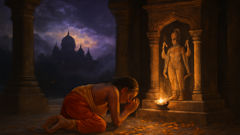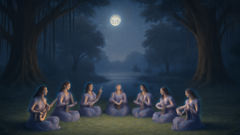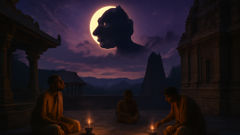Introduction
In the valleys where the Ganges first remembers the mountains, in a time that seems both nearer and farther than memory, a small kingdom trembled under the rule of one who mistook power for law and pride for destiny. Hiranyakashipu, mighty king and ruthless tyrant, rose from a lineage of demons and devas tangled in prophecies and fury. From the golden verandahs of his palace to the dusty river paths where children chased dragonflies, his name carried both fear and authority. He declared himself inviolable, challenging the hidden order that binds mortals and gods. Yet within this palace of carved pillars and painted ceilings lived a child who refused to bend: Prahlada, the son of the king, with eyes like dusk and a heart that held a light not made by royal decree. He loved a name most men had forgotten how to say without a sneer — Vishnu. Prahlada’s devotion was quiet and stubborn, like a stream that keeps its course through rock, not by violence but by constancy. The boy’s faith did not sprout from ritual alone; it grew in small acts: a flower placed at a shrine, a whispered hymn before sleep, a question asked aloud about kindness when elders rewarded cruelty. Word of his devotion spread through the court like incense smoke — not because the boy shouted, but because truth has a way of finding voices. For the king, his son’s reverence became an insult to everything Hiranyakashipu had built. In his rage, the king waged argument and punishment, ceremony and spell, seeking to tear the child’s belief from him as if it were a weed to be plucked. But faith does not always respond to force, and the gods do not always answer in kind; sometimes they answer in awe. In this telling, we follow Prahlada not as an untouchable saint but as a small, stubborn human child who loves what he cannot yet explain. We watch how devotion grinds against tyranny and how, when the boundary between heaven and earth thins, the world itself reshapes. This is the story of a boy and a god, of a roar that brought the sky closer to the earth, and of the way mercy and justice braided together into a single, terrible compassion.
The Boy Who Kept Faith
Prahlada’s faith was not a tale of miracles and sermonized perfection. It began as the steady practice of a child who found comfort in rhythm and name. He learned the hymns by the cadence of the seasons: the monsoon chorus that washed the courtyard clean, the autumn hush when the courtyard figs dropped their velvety fruit, the restless wind that carried merchants’ songs from the bazaar. His devotion to Vishnu first surprised his nursemaid, then the temple priests, and then the courtiers, who counted loyalty in favors and triumphs rather than in the quiet of private prayer. The court watched with the curiosity reserved for misfits and for any anomaly that might become gossip. Hiranyakashipu heard. At first he dismissed the boy’s piety as a child's fancy, a harmless quirk that could be corrected with silence and ceremony. But when Prahlada spoke of Vishnu as if the god were present — when he asked why people worshipped power and yet granted only cruelty — the king's patience wore thin. Power, Hiranyakashipu taught the court, was the net by which order must be kept. In his view, the gods were instruments or metaphors at best; at worst, they were rivals that might unsettle his achieved order. So the king enacted punishments that were meant to teach fear. They began with lectures that bent like iron and escalated through scorn and fearsome threats. Yet with each attempt to force the boy into submission the opposite happened: the child's answers were not defiant in the way of a spoiled son who wants his way, nor were they meek confessions seeking mercy. He was small, yes, but his replies bore the particular simplicity of someone who had placed his trust in another order. "Vishnu is kind," he would say, and the certainty startled those who mistook certainty for ignorance. When priests of the court whispered of spells and curses, the child listened with the contemplative air of someone who cataloged each sound before judging it. The king's designs moved next to physical trials. Men of violence were instructed to employ every cruelty a palace could invent: thorn beds, venom, extreme isolation, and coldly narrated threats. Yet in that long stretch of torment, something remarkable happened: instead of bitterness, Prahlada returned to the world with the easy generosity of a child who has learned to count his treasures differently. He loved small things — the way the river smelled when it met the sun, the patient watchfulness of an old cow, the smooth column of his father’s palace with its carved elephants that looked as if they had once roamed forests. Each time he was sent back to the palace after being rescued by tender hands or by nameless kindness, his faith felt less like the brittle faith of hope and more like a woven garment that could not be torn without changing the fabric of the weaver who made it. Observers began to notice how his face altered when he spoke of Vishnu; it was not the rapture of fanaticism but the calm of someone who had anchored himself to an unshakable truth. This steadiness disturbed and unsettled the king further. He did not understand how a child could outrank pride. In his fury, Hiranyakashipu consulted scholars and sorcerers. Prophecies were reexamined, occult instruments were read, and the king bent the court into a frenzy of countermeasures. Yet each device and spell that aimed to wrench the boy’s faith only made the story of Prahlada spread wider, carried by servants, merchants, and the occasional soldier who left the palace with a new, troubled question lodged like a seed in his heart. The question was simple: if a child can love the divine in secret, what does that say about the nature of power? The answer waited, patient as a winter root.
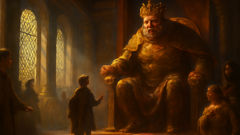
He did not fight with slogans or ideology; he fought with presence. Prahlada answered not with hatred but with the kind of stubborn, luminous gentleness that becomes a mirror to the one who lashes out. "Why would Vishnu leave you to loneliness?" he asked once in the throne room, and his voice trembled not with fear but with earnest curiosity. "Does the god hide because the world is wrong, or because the world does not yet see?" It was a question that reframed rage into doubt, and doubt is a thing that often gnaws at certainty. In this way, the boy became a mirror in which the king had to confront the contours of his own cruelty.
Despite the seeming humiliation of questioning, Hiranyakashipu pressed onward, and in that pressing he finally invoked the cosmic gamble — the kind of implacable, riven logic that myth uses to separate the cosmic from the mundane. He sought the invulnerability of prophecy: protections designed so subtly and so tightly around himself that he believed no being could unmake them. The king's wish was not born of wisdom but of fear; he desired a fortress not of walls but of paradox. Yet stories like this do not dissolve in the heat of human cunning. They summon another intelligence: one that measures law in balance, that hears the prayers of children and the sighs of trees. So when the hour grew heavy and the palace lamps burned late into the night, some watchers say it was the world itself that leaned closer. In courtyards and temples, in riverbeds and kitchen hearths, people looked up as if to catch the breath of the sky. And in the hush before change, a presence settled into the wood grain of the palace columns and the grain of the king’s own heart — the presence of a god who prefers remedy over retribution but does not shrink from the necessity of both.
Even as plans were made for an ultimate test, the people of the city murmured prayers: not the hurried offerings of a court but the slow, sticky blessings of lives lived on the margins. When the appointed day came, they watched, each citizen holding a private kernel of hope for what might unfold. For their prayers were not simply petitions for spectacle; they were requests for justice to take on form. In all these small notes — the boy’s steady hymns, the nursemaid’s whispered defenses, the anxious prayers of market women — the pattern became clear: devotion had a way of summoning forces that the loud and proud of this world could never truly command. A long night closed, and as it did, the palace prepared for either triumph or ruin. The tale that follows moves from the quiet stubbornness of a child to an eruption that reshapes how power and compassion are understood. It is both a lament and an answer, a reprimand to cruelty and a reminder that sometimes the protective hand of the divine comes in a form you could not have expected.
Narasimha's Wrath and the Lesson of Devotion
When all human measures failed to bend the boy’s faith, the world answered with an avatar that married mercy to necessary violence. The hour was neither wholly night nor pure day; it bent at the edges like a threshold where rules blur and new ordinances are written. Hiranyakashipu, drunk on the idea of invulnerability, recited the charters of his protection aloud: he would not be killed in day or night, neither indoors nor outdoors, neither by man nor beast, neither on earth nor in the sky, neither by any weapon forged by human hands nor by any supernatural instrument that fit prior definitions. Such cunning seemed final to those who measure safety by loopholes. But divinity, when it moves to restore balance, often finds the seam of a paradox and unthreads it with a hand the human eye cannot predict. The legend tells that Vishnu himself, moved by the boy’s pure devotion and by the cruelty that had grown like mildew across the king’s soul, chose a form that could not be contained by the king’s own syllogisms. He came as Narasimha — neither man nor beast, a furious figure with the body of a man and the head of a lion, muscles taut and mane like a sunburst. Narasimha’s arrival was not theatrical in the way a court summons an army; it was immediate and intimate as a storm striking the old banyan that had witnessed the city’s prayers for generations. He emerged not from the heavens in a chariot but from the threshold between palace and garden, appearing on the palace veranda at the instant when day was folding into dusk. That threshold — neither inside nor outside, neither day nor night — was the crack through which the divine made a law that the king’s protections could not conceive.
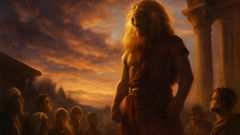
The encounter has often been described with roaring and tearing, but the heart of it is more complicated: it is a rebuke couched in rescue. Hiranyakashipu met Narasimha with the arrogance of one who believes he has already outmaneuvered fate. He would demand respect from gods and men alike, and the appearance of a figure both more ancient and more immediate than his pride enraged him beyond reason. Narasimha’s anger was not petty; it was cosmic. It is easy to mistake that anger for bloodlust if you forget the wrongs that had accumulated like dry tinder: the boy’s pain, the market women’s prayers, the broken bones of those who had dared to whisper about mercy. When Narasimha tore the armor of arrogance from the king’s chest, it was as though a skylight had been thrown open in a room that had been sealed for ages. The violence of the act — the ripping of flesh from armor, the sudden exposure of a human heart to light — served to make the moral point unbearable to watch. Evil, when it uses the infrastructure of religion and state to shield itself, must be unmasked; otherwise it hardens into a new order that claims righteousness by default.
But Narasimha did not revel in destruction. There is a tenderness in divine wrath as much as there is finality, and that tenderness is what the people often miss when they focus solely on the roar. After the king fell, after the hush that follows any great calamity, Prahlada ran to the place where the avatar stood and touched the tawny, hot fur with the innocent confidence of a child whose prayers had become flesh. Narasimha looked down and, in most renderings of the tale, did not punish the child. Instead, he received the embrace, confirming that the purpose of the display was restoration rather than mere annihilation. In the aftermath, the community found a strange, renewed balance — a recognition that the sacred could intervene to correct the course of injustice, and that devotion in a child had been the hinge on which the world turned. The city’s rituals changed subtly. Where once hymn and sacrifice might have been performed like mechanical rites, they became petitions for vigilance and compassion. Priests and merchants began to measure piety not by distance from suffering but by proximity to it: who fed the hungry, who sheltered the weak, who kept the river from choking on communal apathy. The story’s teaching is not merely punitive; it is a call to a different kind of bravery. The bravery that Prahlada modelled — to name love where others named ownership, to keep faith when pragmatism invites compromise — became a kind of moral grammar the city relearned. Children were taught not merely to memorize names but to understand the qualities behind them: mercy, protection, the courage to stand with those who are alone.
There are layers to this myth that history cannot fully separate: an origin myth, a liturgical text, a lesson in governance, and above all a story of human transformation. In some villages, storytellers added details to soothe the rough edges: markets were described with more color, the king’s palace became a setting of exaggerated ornament, and the figure of Narasimha was softened in some telling into a protector of smaller injustices, a guardian who watched over the threshold where the fields met the forest. In city temples, the retelling was more austere, focused on the sanctity of divine law. But across variations, one line binds them: the idea that devotion, even in a child, can awaken principles larger than political machinations. That awakening does not guarantee an easy life; it guarantees rather that cruelty will not have the last word. The tale ends not with a simple victory but with a reconstitution of social memory. Prahlada grows, his life a testimony to the delicate balance between humility and authority. He becomes a leader, not because he sought power but because life after the revelation demanded stewardship. The people who had hidden their doubts behind commerce and ceremony were forced to reconsider what it meant to be a city that cared for its weakest. Temples kept new rituals, and new songs found their way from the riverbanks to the royal veranda. The lesson, if it can be boiled down without losing its aroma, is this: devotion is not the denial of practical wisdom, nor is it an indulgence in fantasy. It is a mode of attention that trains a person to notice suffering and to act. Prahlada’s attention was what dislodged a centuries-old arrogance; Narasimha’s intervention was the cosmic correction. This duality — human fidelity and divine response — is what allows the myth to keep breathing across generations.
Finally, the story endures because it asks an uncomfortable question of every listener: when you see cruelty, do you merely record it or do you name it? Prahlada named it, and in naming he summoned something far larger than himself. Narasimha answered, and his answer was both violent and compassionate, a reminder that sometimes justice demands force, but that force, guided by mercy, becomes redemption rather than revenge. In the quiet that follows the myth, listeners are left with the responsibility that stories like this confer: to hold remembrance, to teach sacrifice not as drudgery but as tenderness, and to understand that the divine may arrive in forms we cannot predict, especially when a child’s song persists louder than a king’s decree.
Conclusion
The legend of Prahlada and Narasimha continues to travel across centuries not because it offers a tidy moral or a theatrical end, but because it models a persistent truth: that devotion, when practiced with the humility of attention, has the power to displace cruelty and to reimagine justice. Prahlada’s life shows that courage does not always shout; sometimes it prays, listens, and returns to kindness even after being hurt. Narasimha’s intervention reminds us that the moral order of the universe sometimes takes stern measures to correct an imbalance, but those measures are aimed at restoration rather than mere retribution. The myth invites readers to consider what it means to stand at thresholds — between inside and outside, law and compassion, pride and penitence — and to hold the possibility that the divine sometimes meets us in forms that defy simple categories. In temples and kitchens, in classrooms and living rooms, the story presses a question into our hands: how will we answer when faced with cruelty dressed as certainty? Will we protect the vulnerable and teach the next generation to see beyond appearances? Will we marry strength to mercy? Stories like this survive because they demand an ethical imagination, one that reshapes ordinary lives into practices of care. To retell Prahlada and Narasimha is to keep a lamp lit in the vestibule of the heart: a lamp that warns against arrogance and warms those who would dedicate their lives to compassion. If we listen carefully, the tale continues to teach that faith can be small and very brave, and that when human fidelity meets the vastness of the divine, the world often finds a new balance.

